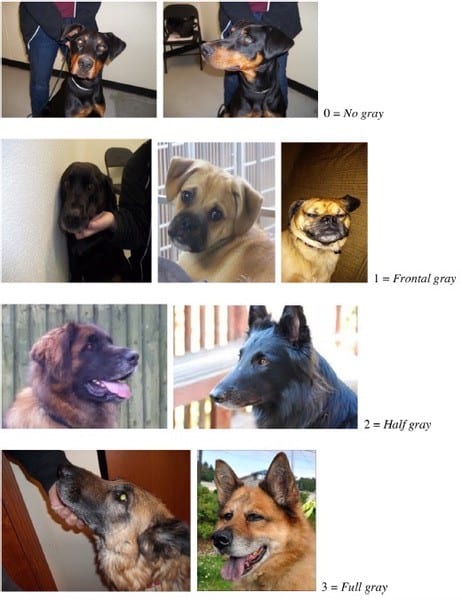“This post contains affiliate links, and I will be compensated if you make a purchase after clicking on my links.”
We’re all well aware that stress can lead to premature aging – and those pesky gray hairs – in humans. Now, research by Northern Illinois University says stress and anxiety can turn our dogs’ hair gray, too!

The research, published in Applied Animal Behaviour Science, analyzed the 42-items questionnaires of 400 owners of dogs between the ages of 1 and 4 throughout the Denver area. The surveys provided information including the dog’s age, activity level, and overall health, along with a series of questions to determine if their pets exhibited stressful behavior – like, destroying things when left home alone, if they shed heavily at the vet, if they tend to be afraid of crowds of people, etc – and the dogs’ impulsivity, based on behaviors such as jumping on visitors, how easy it is for them to maintain focus, etc.
Researchers then photographed the dogs and gave the photos to independent raters, who gauged the dogs’ amount of gray hair.

Credit: King, C. et al. Applied Animal Behaviour Science (2016). Creative Commons.
The study revealed that “both anxiety and impulsivity were significantly associated with premature graying in dogs between 2 and 4 years of age.”
LiveScience explained, female dogs tended to have higher levels of grayness than male dogs did. And, dogs that showed fearfulness toward loud noises and unfamiliar animals and people tended to have increased grayness.
In contrast, grayness had nothing to do with the dog’s size, whether it was spayed or neutered, and whether the dog had any medical problems.
“At first, I was somewhat skeptical of the hypothesis,” said study co-researcher Thomas Smith, a professor in the College of Education at Northern Illinois University. “However, when we analyzed the data, the results actually were quite striking.”

Beyond just being fascinating, the results of the study could have practical applications. Specifically, veterinarians, behaviorists, and pet parents that notice young dogs going prematurely gray should look into whether their dog is experiencing stress, anxiety, fear, or impulsivity issues and, if necessary, take steps to better help dogs cope with the world around them.
“This is an original, unique study that has implications for dog welfare,” said study co-researcher Temple Grandin, a professor of animal science at Colorado State University.

















